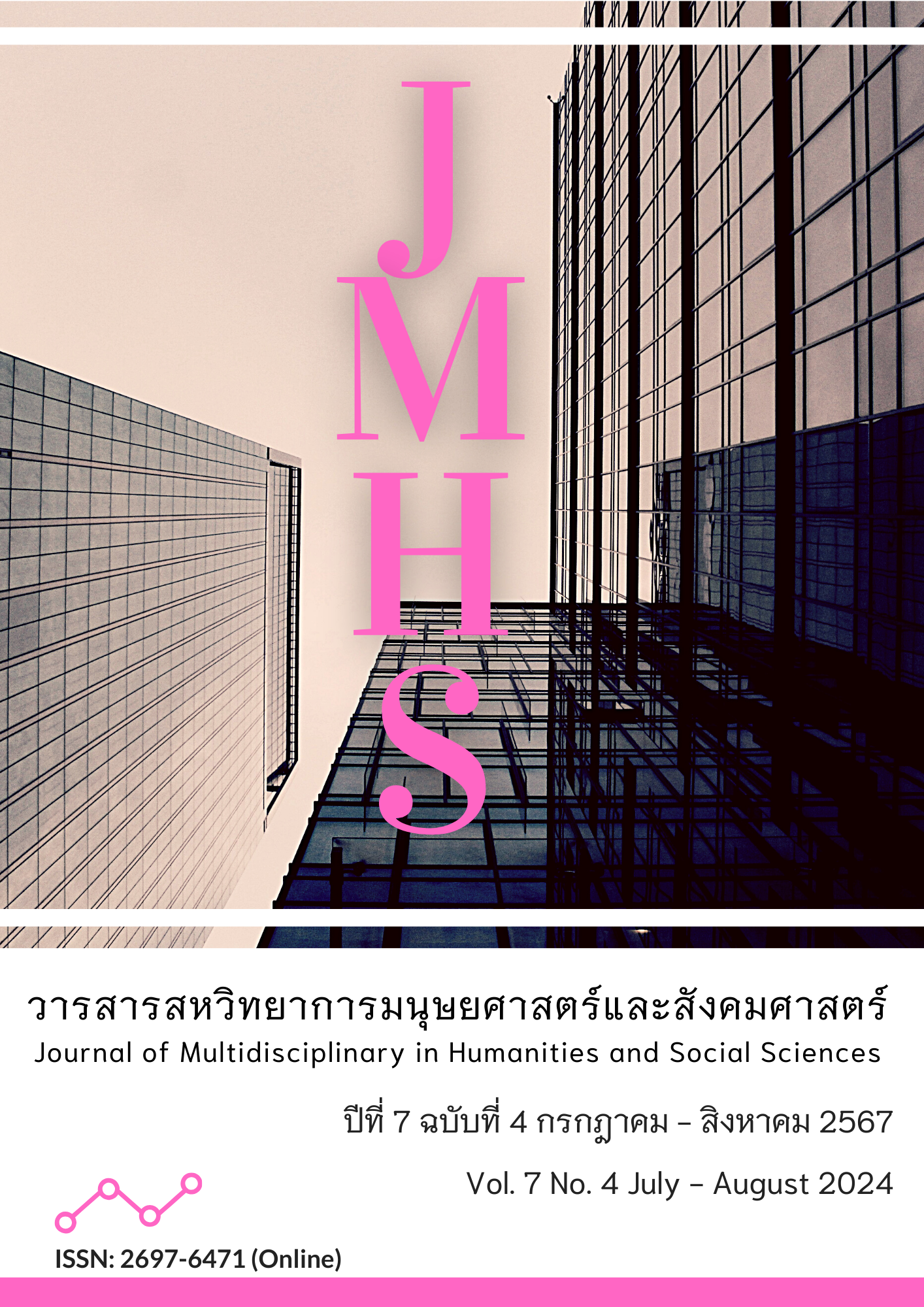Model Development of School Administrators’ Digital Leadership Affecting Internal Quality Assurance Under Surat Thani Primary Education Service Area Office 3
Main Article Content
Abstract
This article aimed to (1) study the actual and expected conditions of digital leadership levels and internal quality assurance operations in educational institutions; (2) develop a model of digital leadership that affected the operation of internal quality assurance in educational institutions; and (3) examine the consistency of the causative structural model created according to theory with empirical data. It was mixed-methods research. The sample group consisted of 84 school administrators and 252 teachers, totaling 336 individuals; probability sampling was selected through multi-stage random sampling. The research tools included questionnaires and interviews. The statistics used for data analysis included mean, standard deviation, t-test, structural equation modeling analysis, and content analysis. The research findings were as follows:
1. The digital leadership level of school administrators and the operation of internal quality assurance in schools were found to be high in terms of actual condition, with an average score of 4.18, and the expected condition was also high, with an average of 4.39. This difference was statistically significant at the .05 level.
2. The developed digital leadership model of school administrators impacting internal quality assurance operations within educational institutions was a causal relationship structural model comprising 4 components and 13 indicators, including digital literacy, digital vision, promoting digital learning, and internal quality assurance operations in schools.
3. The causal relationship structural model was consistent with the empirical data, as indicated by 2 = 64, df = 49,
2/df = 1.31, CFI = 0.97, TLI = 0.96, RMSEA = 0.02, SRMR = 0.02 and a predictive coefficient = 0.74.
Article Details

This work is licensed under a Creative Commons Attribution-NonCommercial-NoDerivatives 4.0 International License.
Views and opinions appearing in the Journal it is the responsibility of the author of the article, and does not constitute the view and responsibility of the editorial team.
References
จิติมา วรรณศรี (2564). การบริหารจัดการศึกษายุคดิจิทัล. พิษณุโลก: รัตนสุวรรณการพิมพ์ 3.
ชุติรัตน์ กาญจนธนชัย, พระมหาไกรวรรณ์ ชินทตฺติโย และ สุวิทย์ ภาณุจารี. (2563). ตัวบ่งชี้ภาวะผู้นำดิจิตอลของผู้บริหารสถานศึกษา สังกัดคณะกรรมการการศึกษาขั้นพื้นฐาน. วารสารบัณฑิตศาส์น มหาวิทยาลัยมหามกุฏราชวิทยาลัย, 18(2), 102-111. สืบค้นจาก https://so04.tci-thaijo.org/index.php/mgsj/article/view/245419/168380
ดาวรุวรรณ ถวิลการ. (2564). ภาวะผู้นำดิจิทัล. ขอนแก่น: มหาวิทยาลัยขอนแก่น.
ธีรศักดิ์ อุปรมัย อุปไมยอธิชัย และ สุชาติ บางวิเศษ. (2563). การบริหารและการจัดการศึกษาสู่การพัฒนาที่ยั่งยืน. พิษณุโลก: มหาวิทยาลัยนเรศวร.
ราชกิจจานุเบกษา. (2562). พระราชบัญญัติการศึกษาแห่งชาติ (ฉบับที่ 4). เล่ม 136 ตอนที่ 57 ก หน้า 51 (1 พฤษภาคม 2562).
เลอศักดิ์ ตามา และ สุมาลี ศรีพุทธรินทร์. (2564). ภาวะผู้นำยุคดิจิทัลของผู้บริหารสถานศึกษาที่ส่งผลต่อการดำเนินงานระบบประกันคุณภาพการศึกษาของสถานศึกษา สังกัดสำนักงานเขตพื้นที่การศึกษามัธยมศึกษา เขต 22. วารสารรัชต์ภาคย์, 15(38), 224-240. สืบค้นจาก https://so05.tci-thaijo.org/index.php/RJPJ/article/view/248088/169560
วีระยุทธ ชาตะกาญจน์. (2556). เทคนิคการบริหาร สำหรับนักบริหารการศึกษามืออาชีพ. (พิมพ์ครั้งที่ 3). กรุงเทพฯ: จุฬาลงกรณ์มหาวิทยาลัย.
สำนักงานเขตพื้นที่การศึกษาประถมศึกษาสุราษฎร์ธานี เขต 3. (2566). แผนพัฒนาการศึกษาขั้นพื้นฐาน ระยะ 5 ปี พ.ศ. 2566 - 2570. สุราษฎร์ธานี: สำนักงานเขตพื้นที่การศึกษาประถมศึกษาสุราษฎร์ธานี เขต 3.
สุกัญญา แช่มช้อย. (2565). การบริหารวิชาการที่ตอบสนองการเปลี่ยนแปลงของโลกยุคพลิกผัน. กรุงเทพฯ: จุฬาลงกรณ์มหาวิทยาลัย.
สุชาดา สุขบำรุงศิลป์, ภารดี อนันต์นาวี และ สถาพร พฤฑฒิกุล. (2563). การพัฒนารูปแบบการบริหารจัดการประกันคุณภาพภายในที่มีประสิทธิภาพของโรงเรียนมัธยมศึกษา สังกัดสำนักงานคณะกรรมการการศึกษาขั้นพื้นฐาน. e-Journal of Education Studies, Burapha University, 2(3), 17-33. สืบค้นจาก https://www.tci-thaijo.org/index.php/ejes/article/view/242211
สุพัตรา สุวรรณชัยรบ และ สุวัฒน์ จุลสุวรรณ์. (2565). โปรแกรมเสริมสร้างทักษะภาวะผู้นำดิจิทัลของผู้บริหารสถานศึกษาสังกัดอาชีวศึกษาจังหวัดร้อยเอ็ด. วารสารบัณฑิตศึกษา มหาวิทยาลัยราชภัฏสกลนคร, 19(84), 31-40. สืบค้นจาก https://so02.tci-thaijo.org/index.php/SNGSJ/
article/view/250213/171711
Bollen, K. A. (1989). Structural equations with latent variables. New York: Wiley.
Diamantopoulos, A., Siguaw, J.A., & Siguaw, J.A. (2000). Introducing LISREL: A guide for the uninitiated. London: Sage Publications.
Eisner, E. (1976). Educational connoisseurship and criticism: Their form and functions in education evaluation. The Journal of Aesthetic Education, 10(3/4), 135-150. https://doi.org/10.2307/3332067
European Commission. (2018). Quality assurance for School development. (2nd ed). Brussels: Belgium. Khaled Almadani.
Flanagan, L., & Jacobsen, M. (2003). Technology leadership for the twenty-first century principal. Journal of Educational Administration, 41(2), 124-142. https://doi.org/10.1108/09578230310464648
Jackson, D. L. (2003). Revisiting sample size and number of parameter estimates: Some support for the N:q hypothesis. Structural Equation Modeling, 10(1), 128-141. https://doi.org/10.1207/S15328007SEM1001_6
Kaplan, D. (2000). Structural equation model: Foundation and extensions. California: Thousand Oaks.
Krejcie, R. V., & Morgan, D. W. (1970). Determining sample size for research activities. Educational and Psychological Measurement, 30(3), 607-610. https://doi.org/10.1177/001316447003000308


